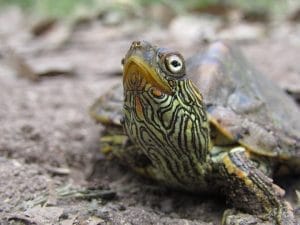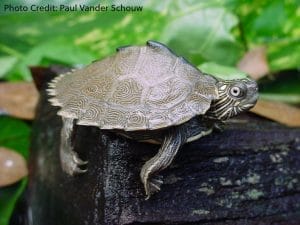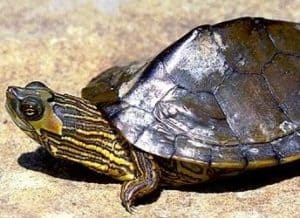Graptemys ernsti (Escambia Map Turtle)
Home > Turtle Database > Graptemys ernsti (Escambia Map Turtle)
The Escambia Map Turtle (Graptemys ernsti) is a medium-sized freshwater turtle native to the southeastern United States. Recognized for its intricately patterned shell resembling a topographic map, this species inhabits a limited range, making it of particular interest to conservationists and herpetologists alike.
Native Turtle Species Map – Find Turtles by Region
Scientific Classification
- Kingdom: Animalia
- Phylum: Chordata
- Class: Reptilia
- Order: Testudines
- Family: Emydidae
- Genus: Graptemys
- Species: G. ernsti
Common Names
- Escambia Map Turtle
- Ernst’s Map Turtle
This Hilarious Turtle Book Might Know Your Pet Better Than You Do
Let’s be real—most turtle care guides feel like reading a textbook written by a sleep-deprived zookeeper.
This one’s not that.
Told from the snarky point of view of a grumpy, judgmental turtle, 21 Turtle Truths You’ll Never Read in a Care Guide is packed with sarcasm, sass, and surprisingly useful insights.
And hey—you don’t have to commit to the whole thing just yet.
Grab 2 free truths from the ebook and get a taste of what your turtle really thinks about your setup, your food choices, and that weird plastic palm tree.
It’s funny, it’s honest, and if you’ve ever owned a turtle who glares at you like you’re the problem—you’ll feel seen.
Identification
Description
The Escambia Map Turtle features an olive to brown carapace adorned with yellowish lines that create a map-like pattern. A prominent keel with spiny projections runs down the center of the carapace, more pronounced in juveniles and males. The skin is dark with yellow stripes along the neck, limbs, and head, including distinctive markings behind the eyes.
Sexual Dimorphism
Significant sexual dimorphism exists in this species. Females are considerably larger, reaching up to 10 inches (25 cm) in carapace length, while males typically grow up to 5 inches (13 cm). Males have longer tails and more pronounced spines on the carapace keel compared to females.
Check more turtles from the Graptemys genus
Native Origin and Distribution
Geographical Range
Graptemys ernsti is endemic to the Escambia, Conecuh, and Perdido river systems in southwestern Alabama and northwestern Florida, USA. Its distribution is confined to these specific freshwater habitats.
Preferred Habitat
This species thrives in clear, fast-flowing rivers and streams with sandy or rocky bottoms. Abundant basking sites like logs and rocks are essential for thermoregulation. The turtles prefer areas with moderate to strong currents and require clean water for feeding and reproduction.
Behavior
Feeding Habits
The Escambia Map Turtle is primarily carnivorous. Its diet consists of aquatic invertebrates such as insects, mollusks, and crayfish. Females, due to their larger size, can consume bigger prey like mussels, whereas males and juveniles feed on smaller invertebrates.
Predators
Predators include birds of prey, raccoons, and large fish species. Eggs and hatchlings are particularly vulnerable to predation by mammals, birds, and other reptiles.
Reproduction
Breeding Season
Breeding occurs in the spring and early summer months. Nesting typically takes place from May to July.
Reproductive Method
Females lay clutches of 5–10 eggs in sandy or soft soil near water bodies. The incubation period ranges from 60 to 75 days, with hatchlings emerging in late summer or early fall. The species exhibits temperature-dependent sex determination, common among many turtle species.
Conservation
Extinction Status
The Escambia Map Turtle is listed as Near Threatened on the IUCN Red List.
Threats
Major threats include habitat degradation due to pollution, dam construction, and sedimentation affecting water quality and flow. Human recreational activities can disturb their habitats, and illegal collection for the pet trade poses additional risks.
Conservation Measures
Efforts focus on habitat protection and management, including monitoring water quality and regulating activities impacting river systems. Enforcement of laws against illegal collection and public education programs are vital for the species’ conservation.
Economic Importance
While not of significant economic value, the Escambia Map Turtle contributes to the biodiversity of freshwater ecosystems. It holds interest for ecotourism and educational initiatives, highlighting the importance of conservation in river habitats.
Interesting Facts
- The species is named in honor of herpetologist Dr. Carl H. Ernst for his contributions to turtle research.
- Each turtle’s shell pattern is unique, much like a human fingerprint.
- Its preference for clean, flowing water makes it an important indicator species for freshwater ecosystem health.

About Author
Muntaseer Rahman started keeping pet turtles back in 2013. He also owns the largest Turtle & Tortoise Facebook community in Bangladesh. These days he is mostly active on Facebook.














